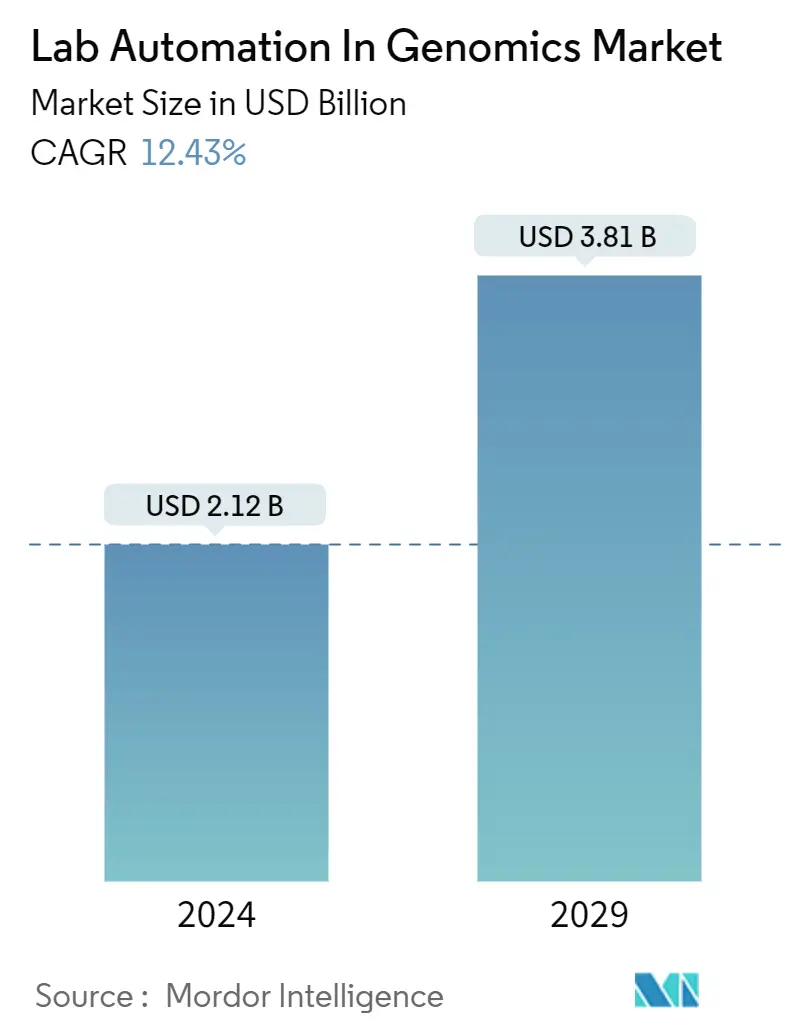Market Size of Lab Automation In Genomics Industry

| Study Period | 2019 - 2029 |
| Market Size (2024) | USD 2.12 Billion |
| Market Size (2029) | USD 3.81 Billion |
| CAGR (2024 - 2029) | 12.43 % |
| Fastest Growing Market | Asia Pacific |
| Largest Market | North America |
Major Players.webp)
*Disclaimer: Major Players sorted in no particular order |
Need a report that reflects how COVID-19 has impacted this market and its growth?
Lab Automation In Genomics Market Analysis
The Lab Automation In Genomics Market size is estimated at USD 2.12 billion in 2024, and is expected to reach USD 3.81 billion by 2029, growing at a CAGR of 12.43% during the forecast period (2024-2029).
There has been a significant improvement in understanding genome sequencing in terms of data analytics advances that reveal unknown correlations, hidden patterns, and other insights, especially when testing data sets on a large scale. This is due to technological advancements and increasing computational capacities driving the market.
- The development of genomics, which uses the availability of whole DNA sequences for entire organisms, is due to the innovative work of a few genomics giants and the more recent next-generation sequencing technology.
- The speed, volume, and price of genome sequencing have all dramatically increased because of the development of next-generation sequence technologies. Additionally, hundreds of life science databases and programs that promote scientific study have been made possible because of advancements in bioinformatics. These databases make it simple to search, contrast, and analyze the information that is organized and kept there.
- Furthermore, significant medical advancements are occurring quickly, mostly due to recent improvements in genomic analysis. DNA sequence analysis clarifies how genetic diversity causes disease and ultimately results in novel treatments. Additionally, laboratory automation has opened space for innovative flexibility, increased throughput, and cost-effective solutions. It allows for quick handling and enables the process to be sped up without worrying about accuracy and dependability. Due to the low cost of genotyping and DNA sequencing, the expansion rate is strong.
- Genetic testing start-ups have been springing up like daisies due to improvements in DNA sequencing technology that have made it more affordable and widely available. However, the knowledge of whole genomes has made functional genomics viable, particularly interested in gene expression patterns under various situations, making it possible for genome sequencing programs to increase rapidly in breadth and speed. The most important tools, in this case, are microarrays and bioinformatics.
- Nucleic acid isolation, RNAi screening, CRISPR analysis, PCR, and gene expression analysis are just a few of the genomics applications that use automation. Laboratory automation players/vendors are developing tools to meet these application requirements. For example, Tecan Group's new "Fluent Automation Workstation" platform incorporates a variety of capabilities to simplify day-to-day laboratory automation and increase workflow productivity. During a run, the system reacts dynamically, adjusting based on actual times to maintain continuous optimal throughput, all of which are visible in real-time via an easy-to-understand Gantt chart.
- The companies are developing new products or incorporating new features in the existing products to meet the needs of the customer. For instance, in May 2023, opentrons, a lab automation solution provider, announced the launch of an Opentrons Flex robot, a liquid-handling lab robot. Flex Robot is compatible with artificial intelligence tools.
- The cost is the major concern in lab automation in the genomics market. The initial setup cost is high, so several developing countries focus on the adoption of cost-effective lab automation systems such as refurbished lab automation. Also, declining consumer spending on buying new and costly equipment due to increasing interest rates and economic downturns restrict market growth.
- The COVID-19 pandemic highlighted the difficulties of high-throughput molecular testing, necessitating a more integrated method to satisfy workload demands without sacrificing results quality, and various partnerships were witnessed in the market focusing on molecular testing. For instance, in February 2021, Tecan, a products, services, and solutions provider for lab processes and medical procedures, and UgenTec, a laboratory software company, announced a partnership to produce fully integrated sample-to-result PCR workflow solutions. Tecan's liquid handling and automation capabilities will be combined with UgenTec's FastFindersoftware, combining end-to-end automation with extensive data analysis and workflow tools to provide high-throughput molecular testing solutions.
